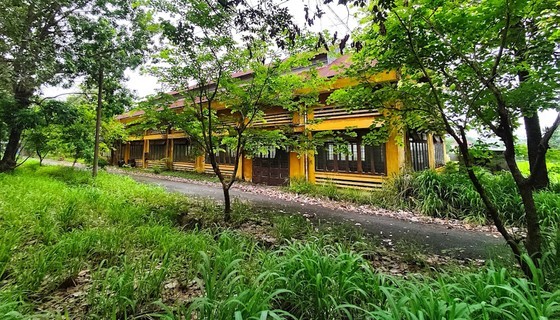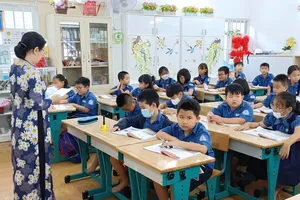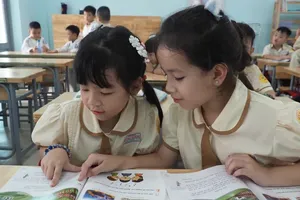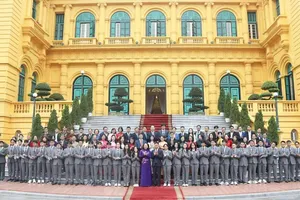 |
| Students of Can Tho Vocational College during an automotive technology practice session (Photo: SGGP) |
There are currently 1,888 technical and vocational education and training (TVET) institutions in the country, including 1,205 public institutions, forming a national network of high-quality key schools, with an enrollment of two million people per year. However, the vocational school system still has many shortcomings, with the lack of proper geographical distribution, low-level enrollment structure, as well as low-quality training. This, as a result, necessitates the rearrangement of substandard vocational schools, improving the TVET quality, and fully developing policies to encourage domestic and foreign organizations as well as individuals to participate in vocational education activities.
The current system of vocational schools features poor management, accompanied by a lack of funds, and failure in student recruitment, hence teaching facilities and equipment are not invested. Despite the situation, viable solutions to resolve the problems remain unknown.
Shrinking enrolment
Located about 15 km from the city center, the second campus of Ho Chi Minh City Agricultural Technical Intermediate School (52, Street 400, Quarter 3, Tan Phu Ward, Thu Duc City) bears the outlook of a tropical forest, as there are clumps of knee-high weeds in front of dilapidated rusty buildings. Behind the rows of moss-roofed houses lies the workshop area, with many dusty old tables and chairs. Even the dormitory, which can accommodate 400 students, is also desolate, with the office area being the only place fully equipped with furniture.
According to student Le Huynh Nhan, who is practicing identifying fertilizers and growing vegetables, it was the outdated teaching facilities that deterred him from studying an intermediate level of mechanical and electrical engineering and switched to acquiring primary knowledge, planning to look for another school to further his education.
Recalling the bygone "golden age" (about 2017-2018), Master Bui Thanh Hung, Head of the Training Department of Ho Chi Minh City Agricultural Technical College, revealed that there were times when the number of students reached 4,500 to 5,000 per year in the intermediate, elementary and regular training systems.
The school was known in the Southern region for training skilled technical workers, fostering economic and technical topics at the request of units and agencies. It is also responsible for training ward and commune cadres according to the policies and goals of the People's Committee of HCMC to serve the needs of industrialization and modernization of agriculture and rural areas. However, the number of students gradually decreased, both for objective and subjective reasons.
“In 2020, the intermediate education level only attracted 400 students, compared to the target of 650; in 2021 the number dropped to 375; and in 2022, only 91 students were recruited. There are currently 31 officers, teachers, and staff in the school. Given the lack of students, many people have quit their jobs," said Master Bui Thanh Hung.
According to him, on April 26, the People's Committee of HCMC issued Document No. 1672/UBND-VX on implementing the arrangement of public non-business units in 2023 according to Resolution No. 19-NQ / TW of the Central Executive Committee, with the item (25) stating that HCMC Agricultural Technical Intermediate School will be merged into a college, university or equivalent unit in the third quarter of 2023.
Poor teaching facilities and cramped classrooms are also seen in the "cluster" of vocational schools located at alley 37/3 Ngo Tat To Street, Ward 21, Binh Thanh District. With a length of less than 100m, the alley has one of its sides occupied by a "combination" of schools crowded on a campus of about 3,000 square meters. On the top of the old two-story building is the signboard of Pasteur College of Medicine and Pharmacy. Next to them are Saigon Intermediate School and the Admissions Office of Hanoi Open University. It is worrying that some schools rent the facilities of Ton Duc Thang Continuing Education Center, not guaranteeing standard teaching and learning places yet still run misleading advertisements on Facebook or Zalo to attract learners.
Stuck in the trough
Regarding the Mekong Delta, with a natural area of nearly 40,000 km², the area includes 13 provinces and cities, and about 18 million people (about 10 million workers), contributing about 18 percent to the national GDP.
The region features 17 universities and 230 TVET institutions, including 26 colleges and 62 intermediate schools, and other TVET-related establishments that mainly provide training in technology, business, administration, agriculture, tourism, and environment. However, in the last decade, the percentage of trained workers at the university level or above only reached nearly 7 percent, while the new TVET system reached 14.9 percent. This shows that the human resource of the region is much lower than the national average of 24.5 percent. According to Mr. Nguyen Khanh Tung, Director of the Institute of Socio-Economics of Can Tho City, the region is undergoing digital transformation and it is forecast that in the near future, regional businesses will need to recruit personnel in software development and data engineering, especially skilled engineers and workers, which is in serious shortage.
 |
The second campus of Ho Chi Minh City Agricultural Technical Secondary School (No. 52, Road 400, Quarter 3, Tan Phu Ward, Thu Duc City) is abandoned and degraded. (Photo: SGGP) |
Meanwhile, according to Deputy Director of the Department of Labor, Invalids and Social Affairs of Can Tho City, Mr. Tieu Minh Duong, Can Tho City currently has 67 TVET institutions with a training scale of 45,000-50,000 people per year, and the percentage of employees who are recruited after graduation reach 87 percent. However, this result is not stable, as some schools are slow to innovate, accompanied with the out-of-date training facilities and equipment of TVET institutes, and the poor connection between TVET institutes and enterprises.
As the southernmost province of the country, Ca Mau currently has 7 TVET institutes, including three colleges with a training scale of about 8,000 people per year. Prominent among them is Vietnam - Korea Vocational College Ca Mau.
As one of the five schools across the country established under the Vietnam - Korea Vocational College project since the 2016-2017 school year, the school is provided with Korean vocational training equipment for four occupations, including automotive technology, refrigeration and air conditioning engineering, mechatronics, and information technology, said School principal Nguyen Hong Nhung.
However, the number of devices only meets the minimum requirements for teaching and learning activities; some devices, in particular, are old, outdated, and basically unusable. Besides, despite the proper training, with the annual enrolment rate reaching over 3,000 people for the college, intermediate, elementary, and regular training systems, there are only 55 teaching staff in the school, which is far from enough.
Leaders of the Ca Mau Department of Labor, Invalids and Social Affairs also admitted that Ca Mau's resources have not been allocated much for investment and development of public TVET institutes.
Many TVET institutions face gloomy future
In the Central region, many colleges and intermediate schools in Da Nang and Quang Nam are subject to increasing hardship in the past 5 years, facing the risk of closing due to the failure in student recruitment. According to the Deputy Director of Da Nang Department of Labor, Invalids and Social Affairs, Le Van Minh, there are currently 61 TVET institutions in Da Nang City, including 17 colleges, 6 intermediate schools, 12 TVET centers and 26 TVET institutions. However, some intermediate schools and colleges have stopped operating as they fail to enroll students.
Duc Minh Economic - Technical Intermediate School (Phan Van Tri Street, Khue Trung Ward, Cam Le District, Da Nang City), has spacious facilities with a four-storey building, on a total area available of 2,500 square meters, but with almost no departments in operation.
According to the school's Chairman Mai Anh Duc, in 2014, the school stopped enrolling students, given the inability to sustain the operation costs. Some students have weak academic ability but still choose to enter a university with low entrance scores rather than a vocational training institution, even when it does not match their interests and aptitudes.
In addition, the fact that some universities are allowed to use alternative admissions methods, such as recruiting based on high school graduation exam scores or high school study results, makes the university education market even more attractive, which eventually worsen the crisis facing colleges and intermediate schools.
























